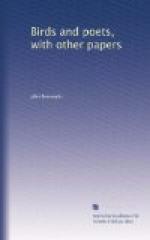The physical cosmos itself is not a thought, but an act. Natural objects do not affect us like well-wrought specimens or finished handicraft, which have nothing to follow, but as living, procreating energy. Nature is perpetual transition. Everything passes and presses on; there is no pause, no completion, no explanation. To produce and multiply endlessly, without ever reaching the last possibility of excellence, and without committing herself to any end, is the law of Nature.
These considerations bring us very near the essential difference between prose and poetry, or rather between the poetic and the didactic treatment of a subject. The essence of creative art is always the same; namely, interior movement and fusion; while the method of the didactic or prosaic treatment is fixity, limitation. The latter must formulate and define; but the principle of the former is to flow, to suffuse, to mount, to escape. We can conceive of life only as something constantly becoming. It plays forever on the verge. It is never in loco, but always in transitu. Arrest the wind, and it is no longer the wind; close your hands upon the light, and behold, it is gone.
The antithesis of art in method is science, as Coleridge has intimated. As the latter aims at the particular, so the former aims at the universal. One would have truth of detail, the other truth of ensemble. The method of science may be symbolized by the straight line, that of art by the curve. The results of science, relatively to its aim, must be parts and pieces; while art must give the whole in every act; not quantitively of course, but qualitively,—by the integrity of the spirit in which it works.




